Elevate Your Bathroom Design with LED Lamps
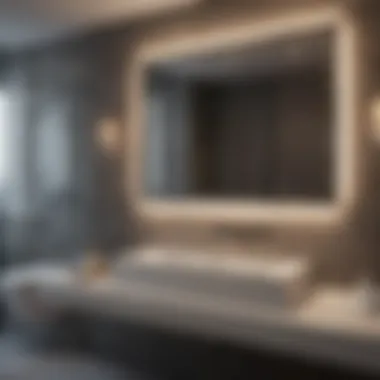

Intro
LED technology has evolved, offering diverse lighting options that cater to different styles and needs. Understanding how to effectively utilize LED lamps can help elevate the ambiance of bathroom spaces while also being mindful of energy consumption and efficiency. This article examines the advantages of LED lamps, practical installation tips, and design considerations, ensuring a comprehensive view for those interested in renovating or upgrading their bathrooms.
Design Inspirations
Design can significantly influence how a bathroom feels. Here are some key elements to consider when integrating LED lamps into the design framework.
Trending Styles
Modern bathroom designs favor minimalism and simplicity. In this context, LED lamps can serve as both functional and decorative accents. Recessed lighting, for example, provides an uncluttered look while still effectively brightening the space. Fixtures like pendant lights and vanity lights are also gaining popularity, allowing homeowners to express their style while ensuring practical illumination.
Traditional designs often embrace softer lighting to create a warm atmosphere. LED lamps that emit a soft glow can complement vintage fixtures, enhancing the overall charm of the bathroom. Consider the balance of old and new, blending modern LED technology with classic designs for a unique aesthetic.
Color Palettes
The choice of color in lighting plays a critical role in bathroom design. LED lamps offer versatility in color temperature, which can change the perceived mood of the space. Warmer colors, such as those around 2700K to 3000K, can foster a relaxing environment, ideal for a soak in the tub. Conversely, cooler tones, like 5000K to 6500K, provide a bright and invigorating atmosphere, suitable for morning routines.
In addition to color temperature, selecting fixtures in shades that complement bathroom tiles, countertops, or wall colors can enhance the visual unity of the design. Neutral colors often provide a sophisticated touch, while bolder hues can add personality and flair.
"The right LED lighting can transform a bathroom from a mere functional space to a polished sanctuary."
Incorporating LED lamps thoughtfully into the color scheme and overall design of the bathroom can make a substantial difference. Whether one chooses to prioritize a modern, clean look or an inviting, traditional aesthetic, LED lighting is a critical component in materializing these visions.
Understanding LED Technology
Lighting is a crucial aspect of any bathroom design. It shapes the ambience and functionality of the space. Understanding LED technology provides insights into its advantages and how it can enhance the overall experience within a bathroom. Importantly, LED lamps offer energy efficiency, longevity, and versatile design options. This knowledge can help homeowners make informed decisions regarding their lighting choices.
Basics of LED Lighting
LED stands for Light Emitting Diode. This technology uses a semiconductor to convert electricity into light. Unlike traditional bulbs, LEDs do not burn out but gradually dim over time. They consume significantly less energy, making them favorable for those conscious of energy bills. Typical LED lamps can last anywhere from 15,000 to 50,000 hours compared to the 1,000-hour lifespan of standard incandescent bulbs.
There are various designs of LED lamps available actively on the market, including standard bulbs, recessed lights, and strip lights. The color temperature, measured in Kelvins, also ranges widely. This allows users to select options that best suit their needs in the bathroom, from warm tones that create a cozy atmosphere to cooler tones for a modern touch.
Comparison with Traditional Lighting
When comparing LEDs to traditional lighting options, the differences are clear. Traditional incandescent or halogen bulbs produce light through a filament that gets hot, which results in wasted energy in the form of heat. In contrast, LED lamps convert energy more effectively into light, providing better illumination for lower power usage.
Key Differences:
- Energy Consumption: LEDs use up to 80% less energy than incandescent bulbs.
- Heat Production: LEDs produce minimal heat compared to traditional light sources, enhancing comfort and safety in enclosed spaces.
- Lifespan: As mentioned earlier, LEDs outlast traditional bulbs, reducing the need for regular replacements.
This efficiency not only results in cost savings for the homeowner but also contributes to a lower carbon footprint.
Common Misconceptions About LED Lamps
Despite their popularity, several misconceptions surround LED technology. One common belief is that LEDs emit harsh, cold light. In reality, LEDs come in a range of color temperatures. Homeowners can choose soft warm whites for a welcoming environment or bright daylight tones for clarity and detail in tasks like grooming.
Another misconception is that LEDs are too expensive. While the initial cost may be higher than traditional bulbs, the long-term savings from lower energy bills and extended lifespan make LEDs more economical over time. Furthermore, many homeowners find that reduced maintenance needs add to the cost-effectiveness of LEDs.
Finally, people often think that installing LED lights is complicated. However, modern designs have made installation straightforward, often requiring no special tools or technical skills.
Understanding LED technology can empower homeowners to create better, more efficient spaces in their bathrooms.
In summary, familiarizing oneself with the basics of LED lighting, comparing it to traditional options, and debunking common misconceptions helps in understanding its role in bathroom design.
Advantages of Using LED Lamps
LED lamps offer several advantages over traditional lighting options, particularly in bathroom settings. Their unique characteristics make them an ideal choice for enhancing both functionality and aesthetics in this personal space. Not only do they contribute to energy savings, but they also provide longevity and a spectrum of light choices. Each of these elements ensures that homeowners can achieve a well-designed and practical bathroom environment.
Energy Efficiency
One of the most compelling benefits of LED lamps is their energy efficiency. Compared to incandescent and fluorescent bulbs, LED lamps consume significantly less power to produce the same amount of light. For instance, an LED bulb can provide an equivalent brightness of a 60-watt incandescent bulb while using only 8 to 12 watts. This efficiency translates into lower electricity bills, which is especially appealing for homeowners aiming to reduce their energy consumption.
Furthermore, the lifespan of LED lamps greatly contributes to energy savings. With an average life expectancy of 15,000 to 50,000 hours, they need far fewer replacements. This reduction in waste not only cuts costs but also minimizes the environmental impact associated with regular bulb disposal.
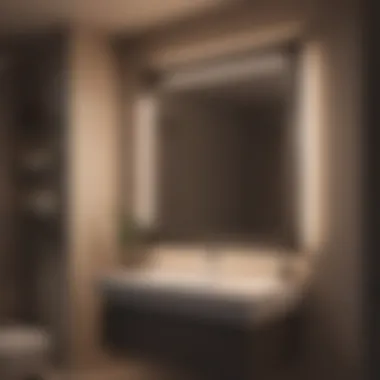
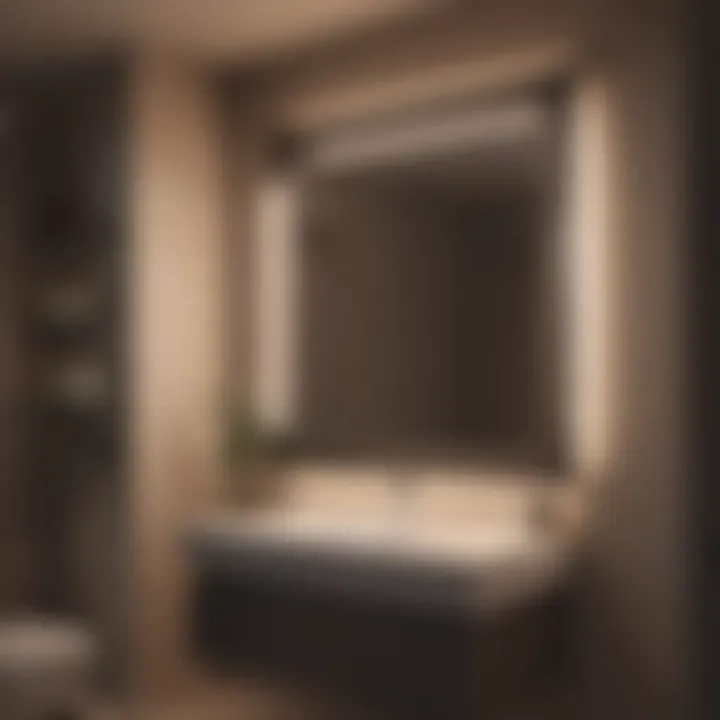
Longevity and Durability
The longevity of LED lamps plays a crucial role in their appeal. They are designed to last much longer than traditional bulbs. The durability of these lamps is enhanced by their solid-state construction, which makes them less susceptible to breakage. For a bathroom, where moisture can be an issue, LED lamps are particularly well-suited. Their ability to withstand temperature fluctuations and humidity makes them a reliable choice for this environment.
In addition to their long lifespan, LED technology maintains its brightness over time. Traditional bulbs tend to dim as they age, reducing the overall effectiveness of the lighting in the bathroom. In contrast, LED lamps offer consistent illumination throughout their lifespan, ensuring that your bathroom remains bright and welcoming.
Low Heat Emission
Heat emission is an important consideration for bathroom lighting. Traditional bulbs, especially incandescent ones, release a significant amount of heat when in use. This can lead to an uncomfortable environment in the often confined and humid space of a bathroom. LED lamps are different; they produce very little heat as they operate. This not only enhances comfort but also contributes to the overall safety of the space.
The low heat emission of LED lights also means that there is a reduced risk of combustion. In areas with installed LED lights near fabrics or materials that may catch fire easily, such as towels or bathmats, this characteristic provides peace of mind for homeowners.
Variety of Color Temperatures
Another advantage is the variety of color temperatures available in LED lamps. Understanding color temperature is vital in creating the desired atmosphere in a bathroom. Ranging from cool white to warm white and even natural daylight, homeowners can choose LED lighting that aligns with their personal preferences or bathroom themes.
- Warm White: Ideal for creating a cozy and inviting atmosphere, often sought after in bathrooms for a relaxing feel.
- Cool White: Perfect for task-oriented areas, such as near mirrors for makeup application and grooming.
- Daylight: Best for achieving a bright, energizing effect, often preferred by those who enjoy bright spaces during the day.
The capacity to select from these different color temperatures allows homeowners to customize the lighting to fit their specific needs, ultimately enhancing the overall design of the bathroom.
Design Considerations for Bathroom Lighting
Effective bathroom lighting is more than just a functional need; it plays a crucial role in the ambiance and overall aesthetics of the space. With LED lamps, the possibilities for achieving ideal lighting conditions are extensive. It is essential to consider how light functions in relation to color, placement, and tasks that take place in a bathroom. Poor lighting can lead to inadequate visibility, affecting daily routines such as shaving, applying makeup, or maintaining hygiene. Thus, understanding the pivotal design considerations ensures both beauty and practicality.
Choosing the Right Color Temperature
Selecting the right color temperature can significantly influence the mood and functionality of your bathroom lighting. Color temperatures are measured in Kelvin (K), and each type brings distinct characteristics that affect the atmosphere.
Warm White
Warm white lighting, typically around 2700K to 3000K, creates a cozy and inviting environment. It is particularly beneficial in bathrooms meant for relaxation, as it mimics the soft glow of traditional incandescent bulbs. The softness of warm white light can make the space feel more spacious and welcoming, making it a popular choice for residential bathrooms. However, its lower intensity might cause challenges in tasks that require precise visibility, such as close grooming tasks.
Cool White
Cool white lighting, ranging from 3500K to 4100K, provides a brighter, more energetic feel. This lighting mimics daylight, helping to energize users as they start their day. Cool white is helpful in settings where clarity matters, such as in task-oriented zones near mirrors. While effective for visibility, some may find it too harsh for a relaxing atmosphere, which is vital to consider in bathroom design.
Daylight
Daylight, measured from 5000K to 6500K, creates a stark and crisp lighting condition. It is particularly useful for detailed tasks as it offers the best color rendering, making colors and skin tones appear more accurate. Daylight LED bulbs elevate the room’s brightness, which can be advantageous in smaller spaces. Nevertheless, this type of lighting can feel too clinical in some contexts, so it should be chosen carefully based on the overall style and purpose of the bathroom.
Layering Light in the Bathroom
Layering various types of lighting enhances functionality and aesthetics. Each layer serves a different purpose and should be considered during the design process.
Ambient Lighting
Ambient lighting provides the base illumination in a bathroom. It is essential for general navigation, ensuring the entire space is sufficiently lit. Usually achieved through ceiling fixtures or overhead lights, ambient light should be evenly distributed to avoid shadows. It is important to choose fixtures that blend well with the interior design for both visual appeal and functionality.
Task Lighting
Task lighting specifically addresses activities that require focus, such as shaving or applying makeup. This type can be achieved through sconces located beside mirrors or directly above, providing clear light without harsh shadows. Task lighting should illuminate the face uniformly, preventing any unwanted shadows. Using LED fixtures for this purpose ensures energy efficiency and longevity.
Accent Lighting
Accent lighting adds character to the bathroom design. It highlights specific elements such as artwork or architectural features. While primarily decorative, it also contributes to the layered lighting effect. However, care must be taken to balance accent lighting with other types, ensuring it does not interfere with necessary visibility in the space.
Focal Points and Fixtures
Focal points in bathroom lighting can be achieved through strategically placing fixtures. Statement pieces, such as a bold chandelier or modern pendant, can become visual anchors in the bathroom design. These elements draw attention while still providing essential light. Choosing fixtures that complement the overall theme of the bathroom enhances its aesthetic appeal.
Decorative vs. Functional Lighting
In the context of bathroom design, it is crucial to strike a balance between style and practicality. Decorative lighting serves to enhance visual appeal, creating a unique atmosphere. However, functional lighting must not be overlooked as it ensures safety and usability. Consequently, a combination of the two types provides both beauty and efficiency. Ideally, the design should prioritize task lighting while integrating decorative elements that match the bathroom’s theme.
Types of LED Lamps for Bathroom Use
When it comes to bathroom design, the choice of lighting is crucial. LED lamps offer a range of options, each with specific benefits and applications. Understanding the different types of LED lamps can enhance the functionality and aesthetic appeal of the bathroom. This section delves into the various kinds of LED lamps suitable for bathroom use, highlighting their advantages and considerations for optimal usage.
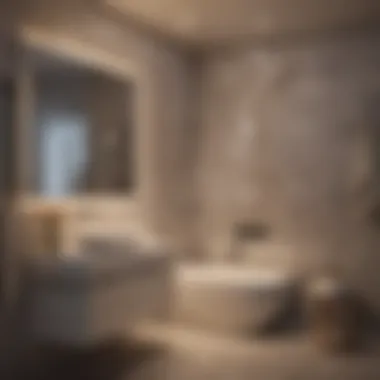
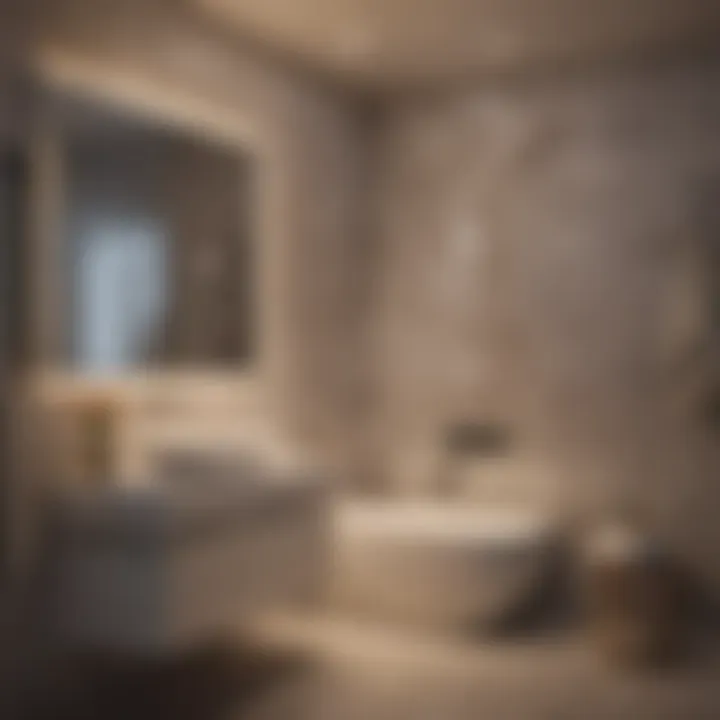
Recessed Lighting
Recessed lighting is a popular choice in modern bathroom design. These fixtures create a clean, streamlined look as they are installed into the ceiling. Their subtle design allows for an uncluttered aesthetic, ideal for smaller bathrooms where space is a concern.
Recessed LED lights provide ample illumination without occupying visual space. They can be directed focus on specific areas, such as the shower or vanity, enhancing visibility while maintaining a soothing ambiance.
Recessed lighting can heighten the perception of space, making bathrooms feel larger.
However, it is vital to ensure that the lights used are suitable for damp locations for safety and durability. Proper placement is also crucial to ensure a well-distributed light effect and to avoid harsh shadows.
Wall Sconces
Wall sconces are another elegant option for bathroom lighting. These fixtures can add a touch of sophistication and are particularly useful for highlighting specific areas. When installed beside mirrors, wall sconces can provide excellent task lighting for daily routines, such as shaving or makeup application.
LED wall sconces come in a variety of designs, from modern to traditional, allowing homeowners to match their existing decor seamlessly. It is important to consider the height at which sconces are installed; ideally, they should be at eye level to minimize shadows. The softness of light emitted also enables a warm atmosphere in the bathroom, contributing to a relaxing environment.
Vanity Lighting
Vanity lighting is specifically designed for use in conjunction with mirrors. This type of lighting can range from fixtures mounted above the mirror to more decorative options flanking it. LED vanity lights provide ample illumination necessary for grooming tasks while also adding to the overall style of the space.
Homeowners can choose from various formats like bar lights or individual fixtures depending on their bathroom size and shape. The choice of color temperature is important here; warmer tones often create inviting and cozy vibes while cooler tones can enhance clarity for cosmetic application.
LED Strip Lights
LED strip lights offer great versatility in bathroom design. These flexible lights can be used to outline fixtures or highlight architectural features, contributing to a more dynamic and layered lighting scheme. Whether installed under cabinets, along the perimeter of mirrors, or around shelving, LED strip lights create unique visual effects and ambiance.
One of the key benefits of LED strip lights is their ease of installation and customization. They are available in various colors and brightness levels, allowing homeowners to adjust the mood according to preference. Furthermore, they can be integrated with smart home systems, enabling remote control for convenience.
Installation Guidelines for LED Lamps
Effective installation of LED lamps is key to maximizing their benefits in bathroom design. Proper guidelines ensure optimal lighting, functionality, and longevity of the fixtures. When considering installing LED lamps, homeowners should prioritize planning, wiring, and placement. Each of these elements plays a critical role in achieving the desired atmosphere and efficiency within the bathroom.
Preparation and Planning
Before diving into installation, careful preparation is essential. Start by assessing the size and layout of the bathroom. This helps in determining how many lights are needed and their types. Consider the specific tasks done in the bathroom—like grooming or relaxing—to identify where lighting needs to be more focused.
Make a list of potential fixtures. Options range from recessed lights to pendant fixtures. Importantly, take note of the color temperature that aligns with your aesthetic preferences. Warm light can create a cozy ambiance, while cooler lights can promote alertness.
When preparing, ensure that you have the necessary tools and materials. Common items include screws, wire strippers, and a voltage tester. It is also wise to turn off the power to the bathroom circuits before starting work, prioritizing safety.
Wiring Considerations
Wiring is a fundamental aspect of installing LED lamps. Proper wiring ensures safety and performance. It is important to use suitable fixtures rated for the bathroom's environment, especially in areas exposed to moisture, like near sinks or showers.
Always follow local electrical codes and standards. This helps in preventing hazards associated with incorrect wiring, such as short circuits or electrical fires. If unsure about handling wiring tasks, consult a qualified electrican to handle the connections.
A few key recommendations for wiring:
- Use insulated wires rated for higher voltage.
- Secure connections with wire nuts and electrical tape.
- Consider using dimmer switches for flexibility in lighting.
Choosing the Right Placement
Choosing the right placement of LED lamps directly impacts both function and design. Start by identifying key areas that require bright lighting. This includes over the vanity, along walkways, and around mirrors.
For ambient lighting, recessed options can be fit into the ceiling, providing a soft overall glow. However, task lighting, such as wall sconces or vanity lights, should be placed at eye level. This positioning prevents shadows, ensuring a clear view while performing tasks.
Consider installation height, too. Higher placements can create a more expansive feel, while lower placements can help create intimacy. It is advisable to test light placement before fixing them, possibly using temporary fixtures to determine the optimal setup.
Proper placement of LED lamps in the bathroom can create a balance between aesthetics and functionality, reinforcing the importance of thoughtful installation.
In summary, the installation of LED lamps in bathrooms requires organized preparation, careful wiring, and strategic placement. Homeowners should not rush through these steps to enjoy the full benefits of LED technology. By taking the time to follow these guidelines, you can enhance the functionality and appearance of your bathroom.
Maintenance of LED Bathroom Lighting
Maintaining LED lighting in the bathroom is essential for several reasons. Over time, dust and grime can accumulate on fixtures, reducing light output and making spaces feel darker. Regular cleaning ensures that the lights remain efficient and visually appealing. Additionally, proper maintenance can extend the lifespan of the bulbs and fixtures, making them a cost-effective option in the long run.
Cleaning LED Fixtures
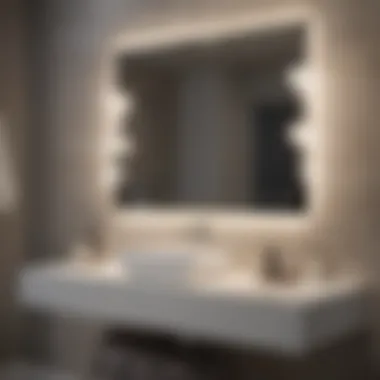
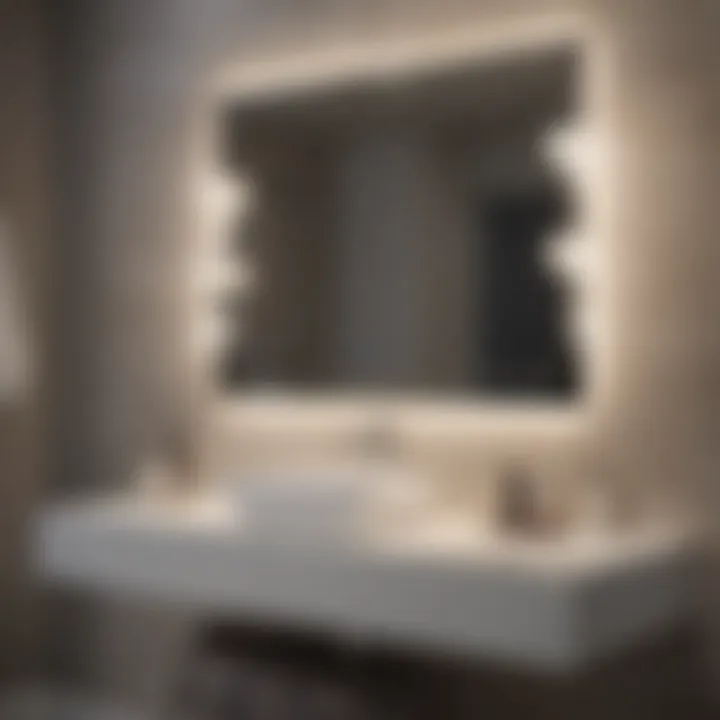
Keeping your LED fixtures clean is straightforward but requires attention. Here's how to do it effectively:
- Turn Off Power: Always begin by switching off the power to avoid any electrical hazards.
- Use a Soft Cloth: Gently wipe fixtures with a soft, damp cloth to remove dust. Avoid harsh chemicals, as they can damage the surface.
- Check for Moisture: If your bathroom tends to be humid, check for moisture build-up. This can affect not only the aesthetic but also the functionality of the lights.
- Inspect for Damage: While cleaning, take a moment to look for any signs of damage or wear. Early detection can save you from more costly repairs later.
Troubleshooting Common Issues
Sometimes, even well-maintained LED lighting may face issues. Knowing how to troubleshoot common problems can save time and stress.
- Flickering Light: This often indicates a loose connection. Ensure that the bulb is fitted correctly into the socket. If the issue persists, check the wiring.
- Dimming or Uneven Light: If your LED light appears dim or inconsistent, it may be due to incompatible dimmer switches. Ensure your dimmers are designed for use with LED lights for optimal performance.
- No Light at All: If the light does not turn on, first check if the bulb is burnt out. If the bulb is new, examine the power supply or try resetting the breaker if needed.
- Color Shift: If the color temperature seems off, it might be worth checking whether the bulb has been exposed to extreme temperatures or whether there is a quality issue with the bulb itself.
Maintaining LED lighting effectively not only keeps your bathroom well-lit but also enhances the overall ambiance and safety.
By following these maintenance tips, homeowners can ensure that their LED lighting remains a reliable and attractive part of their bathroom design.
The Impact of Lighting on Mood and Perception
Lighting serves as a critical element in shaping not only the physical setting of a bathroom but also the emotional experience it provides. The impact of lighting on mood and perception cannot be understated, as the right illumination can transform a space from merely functional to incredibly inviting. When it comes to bathrooms, the significance of good lighting becomes especially pronounced, influencing how one feels during daily routines such as washing up or preparing for the day. It helps create an environment conducive to relaxation, enjoyment, and even functionality.
Psychological Effects of Different Lighting
Different types of lighting contribute varied psychological effects that can affect human behavior and emotions. For instance, bright white light can promote alertness and efficiency, making it suitable for tasks that require focus, such as shaving or applying makeup. On the other hand, softer, warmer lights evoke a sense of tranquility and comfort, ideal for winding down after a long day. Here are a few psychological effects linked to various lighting choices:
- Bright Lighting: Enhances focus and activity levels.
- Warm Lighting: Promotes relaxation and comfort.
- Cool White Lighting: Encourages a feeling of alertness and cleanliness.
Understanding these effects is vital for homeowners who prioritize mood in their design choices. Selecting the right lighting based on intended activities can remarkably enhance the overall bathroom experience.
Creating a Relaxing Atmosphere
Desiring a relaxing atmosphere in the bathroom is common among many homeowners. This urge can be strongly influenced by the type and intensity of lighting employed. Soft, warm LED lights can be strategically placed to create a soothing ambiance. Here are several strategies to consider when aiming for a tranquil space:
- Layered Lighting: Use a combination of ambient and task lighting. Ambient lighting provides a general glow, while task lighting focuses on specific areas, such as mirrors.
- Dimmers: Installing dimmer switches allows for adaptable lighting according to the time of day or mood desired.
- Color Temperature: Choosing warmer color temperatures can induce a sense of calm, making it perfect for evenings or relaxation time.
- Natural Light: Whenever possible, maximizing natural light with strategically placed mirrors can make the space feel more open and inviting.
By considering these elements, you can create a bathroom that not only meets functional needs but also fosters a peaceful retreat within your home.
"The right lighting not only enhances the functionality of a bathroom but also transforms it into a personal haven."
Future Trends in Bathroom Lighting
As the realm of interior design continues to evolve, the bathroom has become a space where functionality meets style. The importance of future trends in bathroom lighting cannot be overstated. LED lamps play a crucial role in shaping these trends, offering not just innovative technology but also integrating aesthetics and energy efficiency. This section will explore two significant aspects: smart LED technology and sustainable lighting solutions, both of which are transforming the modern bathroom.
Smart LED Technology
Smart LED technology involves the use of advanced lighting systems that can be controlled via smartphones or voice-activated devices. This trend represents a significant shift from traditional lighting methods, offering homeowners greater flexibility and control over their lighting environments. Here are several key aspects of this technology:
- Remote Control Options: Homeowners can control the intensity, color, and scheduling of their bathroom lights from anywhere. This can enhance convenience for daily routines.
- Customization: With smart LEDs, users can set different moods by adjusting the color temperature and brightness, transforming the bathroom into a calming spa-like haven or a bright, functional space for grooming.
- Integrative Features: Many smart LED systems integrate with other smart home technologies, such as security systems and climate control, offering a holistic approach to home management.
Smart LED technology represents not just a trend but a shift towards fully integrated and user-friendly lighting experiences. This flexibility can lead to better energy management, as users can turn off lights remotely or set them to operate only during certain hours.
Sustainable Lighting Solutions
Sustainable lighting solutions are becoming essential as environmental awareness grows. The use of LED lamps already presents an energy-efficient alternative to traditional lighting, but the future is focused on enhancing this efficiency further. Consider the following elements of sustainable lighting in bathrooms:
- Recyclable Materials: Many manufacturers are designing LED fixtures with recyclable materials, reducing waste and encouraging eco-friendly practices.
- Energy Management Systems: Some systems allow users to monitor their energy consumption in real time, providing insights into usage patterns and areas for improvement.
- Reduced Carbon Footprint: As the efficiency of LED technology improves, these lights contribute to lowering household energy bills and reducing the overall carbon footprint.
The adoption of sustainable solutions not only supports personal wellness through better design choices but also aligns with broader initiatives for a healthier planet. By integrating these solutions into bathroom designs, homeowners can feel good about their choices while enhancing their living spaces.
"The future of bathroom lighting is bright, with smart technology and sustainability leading the way for informed homeowners looking to upgrade their personal spaces."
By focusing on these future trends, homeowners can revamp their bathrooms with practical, stylish, and responsible lighting solutions. This holds the potential for remarkable improvements in both daily functionality and aesthetic appeal.
Epilogue
In this article, we undertook a detailed examination into the vital role that LED lamps play in bathroom design. This conclusion serves to articulate their significance while recapping the critical points that were discussed.
One major element highlighted is energy efficiency. LED lamps consume less power compared to traditional bulbs, making them a cost-effective choice for homeowners. This benefit extends beyond just financial savings; it also contributes to a more sustainable environment.
Furthermore, we explored the longevity and durability of LED lighting, which translates into fewer replacements over time. This not only alleviates the hassle of constant maintenance but also reinforces the value of making a one-time investment in quality fixtures.
The article also delved into how different types of LED lamps can enhance the aesthetic appeal of bathrooms. From recessed lighting to wall sconces, each option offers unique advantages that cater to various design preferences. It is vital to consider color temperature, as it directly impacts the ambiance and overall perception of space, which is especially critical in smaller bathrooms.
Additionally, we touched on the psychological aspects of lighting. Properly designed lighting can create a relaxing atmosphere that promotes well-being. Its effect on mood should not be underestimated, as it enhances the overall experience of the space.
Lastly, the actual installation of LED fixtures poses its own set of considerations. Proper placement and planning can drastically improve functionality and aesthetic appeal, positioning LED lamps as more than just a necessity but rather a design element in one’s own personal sanctuary.



